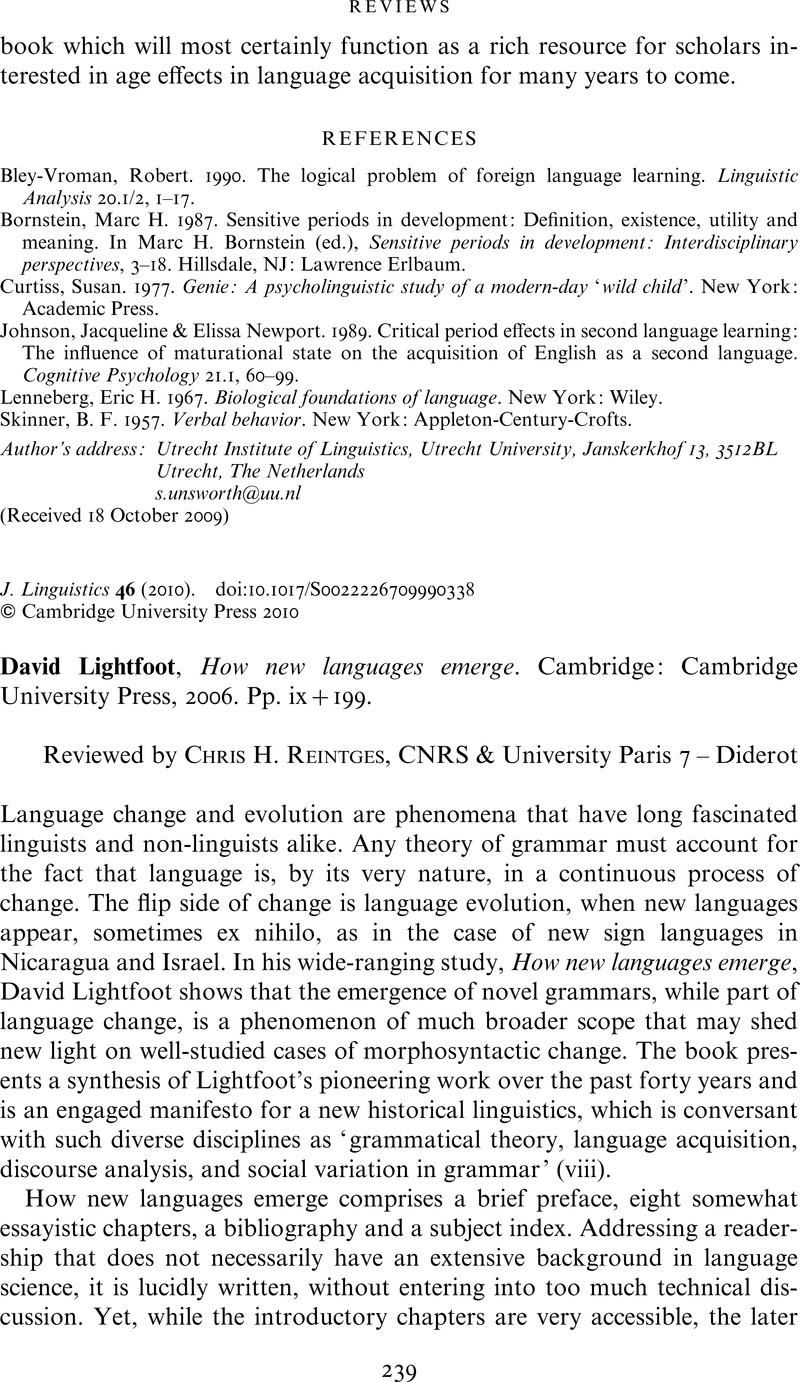No CrossRef data available.
Article contents
David Lightfoot, How new languages emerge. Cambridge: Cambridge University Press, 2006. Pp. ix+199.
Review products
David Lightfoot, How new languages emerge. Cambridge: Cambridge University Press, 2006. Pp. ix+199.
Published online by Cambridge University Press: 22 January 2010
Abstract
An abstract is not available for this content so a preview has been provided. Please use the Get access link above for information on how to access this content.

Information
- Type
- Reviews
- Information
- Copyright
- Copyright © Cambridge University Press 2010
References
Appel, René & Muysken, Pieter. 1987. Language contact and bilingualism. London: Edward Arnold.Google Scholar
Arbib, Michael. 2007. Review of D. Lightfoot, How new languages emerge, 2006. Linguist List 18.432. http://linguistlist.org/issues/18/18-432.html (13 October 2009).Google Scholar
Baker, Mark. 2003. Linguistic differences and language design. Trends in Cognitive Sciences 7.8, 349–353.Google Scholar
Bobaljik, Jonathan D. 2001. The implications of rich agreement: Why morphology doesn't drive syntax. 20th West Coast Conference on Formal Linguistics (WCCFL 20), 82–95.Google Scholar
Bobaljik, Jonathan D. 2002. Realizing Germanic inflection: Why morphology does not drive syntax. Journal of Comparative Germanic Linguistics 6.2, 129–167.CrossRefGoogle Scholar
Bobaljik, Jonathan D. & Höskuldur, Thráinsson. 1989. Two heads aren't always better than one. Syntax 1.1, 37–71.Google Scholar
Bošković, Željko & Lasnik, Howard. 2003. On the distribution of null complementizers. Linguistic Inquiry 34.4, 527–546.CrossRefGoogle Scholar
Chomsky, Noam. 2005. Three factors in language design. Linguistic Inquiry 36.1, 1–22.CrossRefGoogle Scholar
Dunn, Michael, Levinson, Stephen C., Lindström, Eva, Reesink, Ger & Terrill, Angela. 2008. Structural phylogeny in historical linguistics: Methodological explorations applied in Island Melanesia. Language 84.4, 710–759.CrossRefGoogle Scholar
Fischer, Olga, Kemenade, Ans van, Koopman, Willem & Wurff, Wim van der. 2000. The syntax of early English. Cambridge: Cambridge University Press.Google Scholar
Goddard, Denice & Zeijlstra, Hedde. 2009. On the origin of Berbice Dutch VO: A substratist explanation, 33 pp. http://ling.auf.net/lingBuzz/000813 (13 October 2009).Google Scholar
Greenberg, Joseph. 1974. Language typology: A historical and analytic overview. The Hague: Mouton.CrossRefGoogle Scholar
Guasti, Maria Theresa. 2002. Language acquisition: The growth of grammar. Cambridge, MA: MIT Press.Google Scholar
Harris, Alice C. & Campbell, Lyle. 1995. Historical syntax in cross-linguistic perspective. Cambridge: Cambridge University Press.Google Scholar
Haspelmath, Martin. 2004. On directionality in language change with particular reference to grammaticalization. In Fischer, Olga, Norde, Muriel & Perridon, Harry (eds.), Up and down the cline: The nature of grammaticalization, 17–44. Amsterdam & Philadelphia: John Benjamins.CrossRefGoogle Scholar
Huddleston, Rodney. 2002. The verb. In Huddleston, Rodney & Pullum, Geoffrey K. (eds.), The Cambridge grammar of the English language, 71–212. Cambridge: Cambridge University Press.CrossRefGoogle Scholar
Kemenade, Ans van. 2007. Formal syntax and language change: Developments and outlook. Diachronica 24.1, 155–169.CrossRefGoogle Scholar
Kemenade, Ans van. 2009. Discourse relations and word order change. In Hinterhölzl, Roland & Petrova, Svetlana (eds.), Information structure and language change: New approaches to word order variation in Germanic, 91–118. Berlin: Mouton de Gruyter.CrossRefGoogle Scholar
Kießling, Roland & Mous, Maarten. 2004. Urban youth languages in Africa. Anthropological Linguistics 46.3, 303–341.Google Scholar
Kim, Kwag-sup. 2008. English C moves downward as well as upward: An extension of Bošković and Lasnik's (2003) approach. Linguistic Inquiry 39.2, 295–307.Google Scholar
Kouwenberg, Silvia. 1992. From OV to VO: Linguistic negotiation in the development of Berbice Dutch Creole. Lingua 88.3/4, 263–299.Google Scholar
Lanza, Elisabeth. 2004. Language mixing in infant bilingualism: A sociolinguistic perspective. Oxford: Oxford University Press.Google Scholar
Lightfoot, David. 1991. How to set parameters: Arguments from language change. Cambridge, MA: MIT Press.Google Scholar
Lightfoot, David. 1997. Catastrophic changes and learning theory. Lingua 100.1, 171–192.Google Scholar
Lightfoot, David. 2002. Myths and the prehistory of grammars. Journal of Linguistics 38.1, 113–136.CrossRefGoogle Scholar
Lorenzo, Guillermo & Longa, Victor M.. 2009. Beyond generative geneticism: Rethinking language acquisition from a developmentalist point of view. Lingua 119.9, 1300–1315.CrossRefGoogle Scholar
Miller, D. Gary. 2009. Review of D. Lightfoot, How new languages emerge, 2006. Language 85.1, 175–183.Google Scholar
Myers-Scotton, Carol. 1993. Duelling languages: Grammatical structure in codeswitching. Oxford: Clarendon Press.Google Scholar
Pesetsky, David. 1991. Zero syntax, vol. 2: Infinitives, 196 pp. http://web.mit.edu/linguistics/people/faculty/pesetsky/infins.pdf (13 October 2009).Google Scholar
Pintzuk, Susan, Tsoulas, George & Warner, Anthony. 2000. Syntactic change: Theory and method. In Pintzuk, Susan, Tsoulas, George & Warner, Anthony (eds.), Diachronic syntax: Models and mechanisms, 1–22. Oxford: Oxford University Press.Google Scholar
Pullum, Geoffrey K. & Scholz, Barbara C.. 2002. Empirical assessment of stimulus poverty arguments. The Linguistic Review 19.1/2, 9–50.Google Scholar
Reintges, Chris H. 2009. Spontaneous syntactic change. In Crisma, Paola & Longobardi, Giuseppe (eds.), Historical syntax and linguistic theory, 41–57. Oxford: Oxford University Press.CrossRefGoogle Scholar
Roberts, Ian & Roussou, Anna. 2003. Syntactic change: A Minimalist approach to grammaticalization. Cambridge: Cambridge University Press.Google Scholar
Roberts, Sarah Julianne. 1998. The role of diffusion in the genesis of Hawai'ian Creole. Language 74.1, 1–39.CrossRefGoogle Scholar
Thráinsson, Höskuldur. 2003. Syntactic variation, historical development, and minimalism. In Hendrick, Randall (ed.), Minimalist syntax, 152–191. Oxford: Blackwell.Google Scholar

